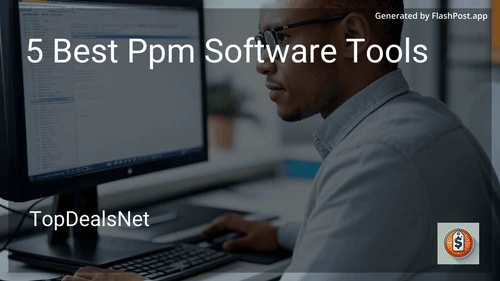Best PPM Software Tools in September 2025
In today's fast-paced business environment, effectively managing projects and resources is crucial. Project Portfolio Management (PPM) software tools play an essential role in helping organizations align projects with strategic objectives, optimize resource allocation, and enhance overall productivity. This guide provides insights into what PPM software is and how to choose the best tools that meet your business needs.
Understanding PPM Software Tools
Project Portfolio Management (PPM) software tools are systems designed to centralize management processes by organizing and analyzing data related to projects, resources, costs, risk assessments, and progress tracking. These tools are invaluable for businesses aiming to assess project potential, prioritize initiatives, allocate resources smartly, and ensure strategic alignment across the board.
Key Benefits of PPM Software
-
Strategic Alignment: PPM tools ensure that all projects align with the overall strategic goals of the organization, maximizing return on investment.
-
Resource Management: Efficient resource allocation and optimization help avoid bottlenecks, underutilization, and overextension of resources.
-
Risk Management: PPM tools provide critical insights into potential risks and bottlenecks, allowing for proactive risk mitigation.
-
Performance Tracking: They enable real-time tracking of project performance, aiding in meeting deadlines and maintaining budgetary control.
-
Informed Decision-Making: PPM software offers comprehensive data analysis capabilities, enhancing decision-making by providing actionable insights.
Choosing the Best PPM Software Tools
Selecting the right PPM software involves considering several factors that cater to the unique needs of your organization. Here are some guidelines to help you make an informed decision:
Assess Your Business Needs and Objectives
Before you start, it is crucial to define your organization's specific needs and objectives. Determine the scale of your projects, the complexity of tasks, and the number of team members involved. This initial assessment will help narrow down the options to those that best fit your strategic goals.
Evaluate Key Features
Consider the essential features that a PPM tool should offer to maximize its utility:
- Project Prioritization: Does the tool allow you to prioritize projects based on strategic importance and resource availability?
- Resource Management: Look for functionality that simplifies resource planning and allocation.
- Reporting and Analytics: In-depth reporting and analytics capabilities can provide insights into performance metrics and future projections.
- User-Friendly Interface: A tool with an intuitive user interface ensures a smoother adoption process across your teams.
- Scalability: The software should be able to grow alongside your organization.
Integration and Compatibility
Ensure that the PPM software you choose is compatible with your current systems and can integrate seamlessly with existing tools like ERP, CRM, or communication platforms. This integration optimizes workflow and data sharing across your organization.
Security and Compliance
In an age where data breaches are prevalent, security features cannot be overlooked. Confirm that the PPM software adheres to industry standards for data security and compliance, protecting sensitive project information from unauthorized access.
Cost Considerations
Budgeting is a critical aspect of selecting the right PPM tool. Evaluate the total cost of ownership, including licensing, implementation, training, and potential upgrade expenses. Align these costs with the expected return on investment to justify the expense.
Trial and Feedback
Leverage trial periods offered by vendors to evaluate the software's performance in real-world scenarios. Gather feedback from team members who will be using the tool regularly to understand its strengths and limitations from a user's perspective.
Conclusion
Choosing the best PPM software tool is a significant decision that can impact your organization's productivity and efficiency. By understanding your business needs, evaluating key features, ensuring compatibility and security, and considering cost implications, you can make an informed decision that aligns with your strategic goals and enhances project management capabilities.
Keep in mind that the right PPM software should not only meet your current demands but also be adaptable to future changes as your organization evolves. Properly selected PPM tools can be powerful allies in driving innovation, efficiency, and success in your project management endeavors.





